A Comprehensive Guide for Month-wise Planning is a valuable resource for fruit growers seeking to improve their orchard management practices. The guide offers a detailed month-by-month breakdown of orchard operations, including tips for pruning, pest management, irrigation, and more. In the early months of the year, the guide recommends focusing on pruning and orchard floor management to prepare for the growing season.
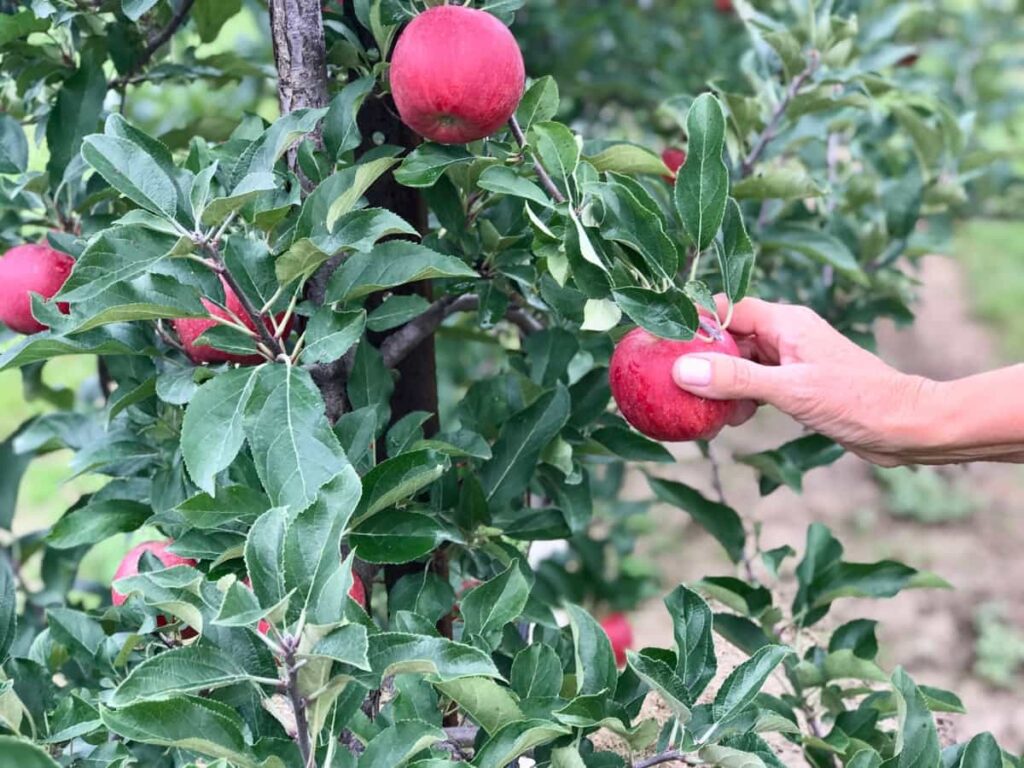
As the weather warms, attention turns to pest management and irrigation to ensure optimal fruit production. The guide also provides advice for harvesting and post-harvest handling. According to industry data, proper orchard management can significantly increase yields and fruit quality. Let’s check out more information on Apple orchard operations below.
What is Apple Farming and its Overview?
Apple farming is the practice of cultivating apple trees for their fruit. Apples are a widely popular fruit consumed worldwide, and the farming of apples is a major industry in many countries. Apple trees are typically grown in orchards and require proper management techniques to maximize yield and fruit quality.
Apple farming has a rich history, dating back to ancient times. Today, modern apple farming techniques incorporate advances in technology and genetics to produce high-quality fruit on a large scale. A major temperate fruit is the apple (Malus pumila). Most apples are eaten raw, but a tiny portion of the crop is processed into juices, jellies, canned slices, and other products.
Best Tips for Apple Production Techniques
Climate: Apple is a temperate fruit crop that grows best in regions with uninterrupted winter rest and abundant sunshine for good color development. The ideal temperature during the active growth period is 21-24°C. The fruit grows best at an altitude of 1500-2700m above sea level, with well-distributed rainfall of 1000-1250mm throughout the growing season.
Varieties: There are many apple varieties suitable for different regions. Some popular varieties include Golden Delicious, Red Delicious, McIntosh, Lal Ambri, Mollies Delicious, Starkrimson, Red June, Irish Peach, Benoni, Tydeman’s Early, KKL 1, Carrington, Winterstein, Rome Beauty, and Parlin’s Beauty.
Soil: Apple trees grow best in well-drained loamy soil with a depth of at least 45cm and a pH range of 5.5-6.5. Soil with heavy clay or compact subsoil and water-logged conditions should be avoided.
In case you missed it: How to Grow Custard Apple in Pots: Soil, Propagation, Planting, and Care

Propagation: Apples can be propagated through several methods, including grafting and budding. Grafting methods include whip, tongue, cleft, and root grafting. Tongue and cleft grafting at 10-15cm above the collar during February-March give the best results. Shield budding is the most popular method and is done during the active growth period when the buds are fully formed. Commonly used rootstocks are those produced from the seeds of diploid cultivars like Golden Delicious, Yellow Newton, Wealthy, Macintosh, and Granny Smith.
Planting: Plant apple trees in January and February, and ensure pollinators are planted in sufficient numbers to ensure effective pollination. The most common planting system is the square system, while in hilly areas, trees are planted on contours to prevent soil erosion and reduce run-off. The average number of plants per ha can range between 200 to 1250(low, moderate, high, and very high-density planting). Combining rootstock and scion differently determines plant spacing and planting density/unit area.
Irrigation: Low soil moisture can cause apple trees to become vulnerable, and water stress throughout the growing season can lead to poor fruit set, significant fruit loss, low productivity, and subpar quality. April through August are the most crucial water-requirement months, with fruit set marking the peak. Irrigation should be provided during dry spells, and orchards should be irrigated immediately after manuring in December-January. The crop should be irrigated weekly after the fruit set, and water applied during the fortnight preceding harvest markedly improves the fruit’s color.
Pruning: Pruning is essential for promoting plant vigor and productivity. Weak-growing and diseased branches should be removed from the tree to force the plant to bear more fruits or vigorous vegetative growth. Apple trees are usually pruned every year in December or January. The three pruning systems adopted in apple cultivation are the established spur system, the regulated system, and the renewal system.
Thinning of Fruit: Heavy bearing in apples can lead to small-sized, poor-quality fruits and alternate bearing cycles. Thinning can regulate cropping and improve fruit size and quality. Chemical thinning is often employed since manual thinning is cumbersome and expensive. Chemical thinners shouldn’t be used in hot, dry weather because they have a negative impact on absorption. It is preferable to keep one fruit per spur, space them 15-20 cm apart, and keep one fruit for every 40 leaves.
Manuring & Fertilization: Farmyard manure is usually applied along with other fertilizers. The fertilizer dose depends on the soil fertility and the amount of organic waste applied to the crop. In divided doses, 300 g N, 170 g P2O5, and 300 g K2O per year is recommended for fully-grown bearing trees. Zinc, boron, manganese, and calcium deficiencies may be observed on some trees, which can be corrected by applying appropriate chemicals through foliage spray.
In case you missed it: Optimizing Mango Orchard Operations: A Comprehensive Guide for Month-wise Planning
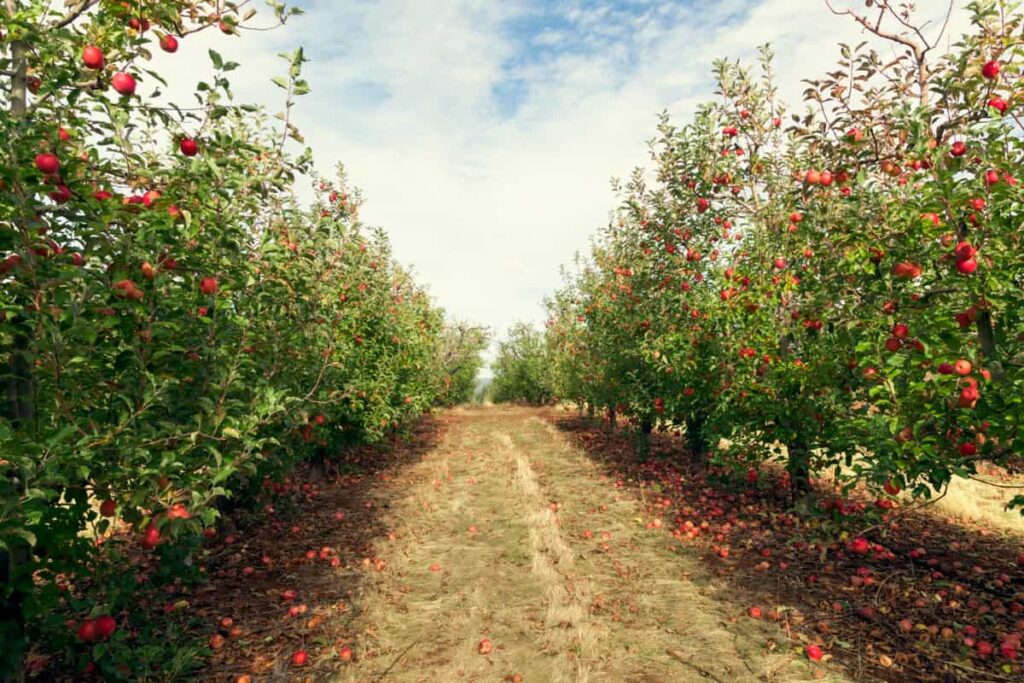
Plant Protection: Insect pests usually observed in apple production are San Jose Scale, white scale, wooly apple aphid, and blossom thrips. Suitable intercultural operations, planting resistant rootstocks, and spraying with chloropyriphos, fenitrothion, carbaryl, and other insecticides effectively control pests. Common apple production diseases include collar rot, scab, sclerotius blight, crown gall, cankers, and die-back diseases. Plants resistant to these diseases should be used for cultivation, and infected plant parts should be destroyed. Fungicides such as copper oxychloride, carbendazim, and mancozeb effectively control these diseases.
Disorders: In apples, Early fruit drops caused by unpollinated or unfertilized blooms, June fruit drops brought on by moisture stress and competition, and pre-harvest fruit drops are the three separate fruit drops. Spraying NAA at ten ppm about a week before the anticipated drop can prevent a pre-harvest drop.
Harvesting: Harvesting of apples is usually done when the fruit has developed full color, the seeds are dark brown, and the flesh is firm. Harvested fruit should be handled with care to avoid bruising and other damage. Proper storage conditions are critical to maintain the quality of the fruit.
Yield: Apple trees bear after four years. A well-managed apple orchard generates 10-20 kg/tree/year.
The Importance of Month-Wise Planning for Apple Orchard Operations
Apple orchard operations require meticulous planning to ensure a successful harvest season. Month-wise planning is crucial for orchard operations as it helps growers keep track of their tasks and maximize productivity.
- Timing is everything: Each stage of apple growth requires specific tasks. Month-wise planning ensures that growers complete the necessary tasks on time, such as pruning, fertilization, and pest control, which are essential for healthy apple growth.
- Resource allocation: Orchards need more labor, equipment, and water. Month-wise planning helps growers allocate these resources efficiently, reducing waste and increasing yields.
- Forecasting yields: Growers can use month-wise planning to track the progress of their apple trees and predict yields. This information can help them make informed decisions about harvesting and marketing crops.
- Managing risks: Orchard operations face various risks, including weather conditions, pests, and disease outbreaks. Month-wise planning helps growers identify potential risks and take preventative measures to minimize damage.
January Month Apple Orchard Operations Planning
- Create a budget for the season, including costs for pruning, fertilization, pest control, and labor.
- Complete dormant pruning, which involves removing dead and diseased wood, as well as thinning out excessive growth.
- Keep fruit-to-shoot growth balanced by selectively pruning branches and buds. This helps ensure that the tree produces fruit evenly and avoids overproduction.
- Improve light penetration by pruning away unnecessary foliage blocking sunlight from reaching the fruit.
In case you missed it: Eco-friendly Strategies: Sustainable Management of Coconut Pests
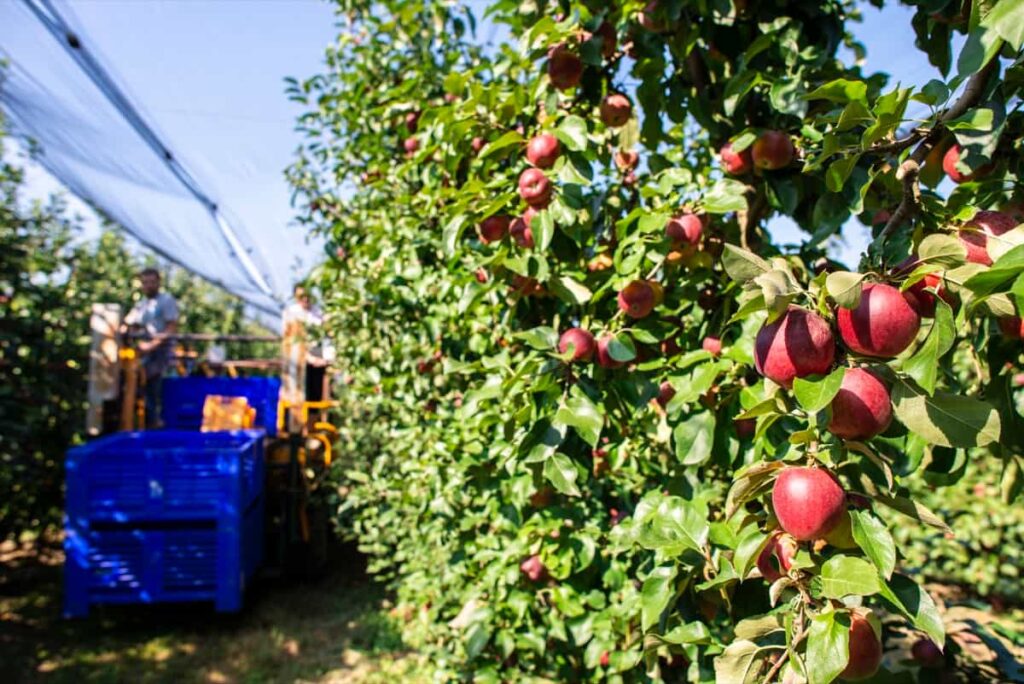
February Month Apple Orchard Operations Planning
- Complete dormant pruning: This activity is essential to balance fruit-to-shoot growth, remove dead wood, and improve light penetration. It should be done every year before the bloom period in February.
- Rake leaves before buds open: This task should be done if completed outside the previous fall. It is essential to reduce the spring population of apple scab spores. Burning, burying, or shredding the leaves will speed up the leaf decay.
March Month Apple Orchard Operations Planning
During March, apple orchard operations planning is crucial for ensuring a successful growing season. Here are some key activities, their purpose, and recommended frequency:
- Bud swell to Green Tip: Apply dormant/spray oil to control spider mites and scale insects. Done once a year if scales and mites are a problem.
- Green Tip to Petal Fall: Apply fungicide for 1st generation apple scab control. This should be done before any rain that causes leaves to stay wet for more than 6 hours. One application protects for seven days or 2 inches of rain, whichever comes first.
April Month Apple Orchard Operations Planning
Apple orchard operations planning for April involves activities to ensure a healthy and fruitful harvest in the coming months.
- During the bloom season, it’s important to identify and mark wild apple trees to remove them at any time to reduce disease and insect pest pressure. Checking trunks for borer attacks that started last year is also crucial to prevent structural damage to the tree.
- To ensure a healthy apple harvest, checking for borers in both May and September is recommended, but once a year.
- If borers are found, it’s important to dig them out if possible. These activities should be done as needed to ensure the health and productivity of the apple orchard.
May Month Apple Orchard Operations Planning
- Apply insecticide: After the petal fall, it’s important to apply insecticide to control plum curculio weevils and reduce codling moths and various foliar and fruit-feeding caterpillars. Use Sevin (carbaryl) and spray 2-3 times at 10-day intervals starting at petal fall. This prevents further spread and loss of branches or trees, improves fruit size, and reduces biennial bearing.
- Remove fire blight infections: As needed, remove fire blight infections to prevent the spread of the disease. The majority of fire blight outbreaks start about a month after flowering.
June Month Apple Orchard Operations Planning
- From petal fall to four weeks before harvest in June, apple orchard operations planning includes applying fungicide at 2-4 week intervals to control secondary apple scabs and prevent diseases like a sooty blotch, flyspeck, and fruit rots.
- The purpose of these applications is to protect the fruit from damage caused by these diseases. It is recommended to apply fungicide before rain, and each application protects the crop for 14-21 days or 2 inches of rain, whichever occurs first.
- The frequency and interval between fungicide sprays depend on the amount and frequency of rainfall and disease pressure, which can be determined through observation and analysis of disease history.
In case you missed it: Cauliflower Insect Pest Management: Effective Tips for Protecting Your Crop
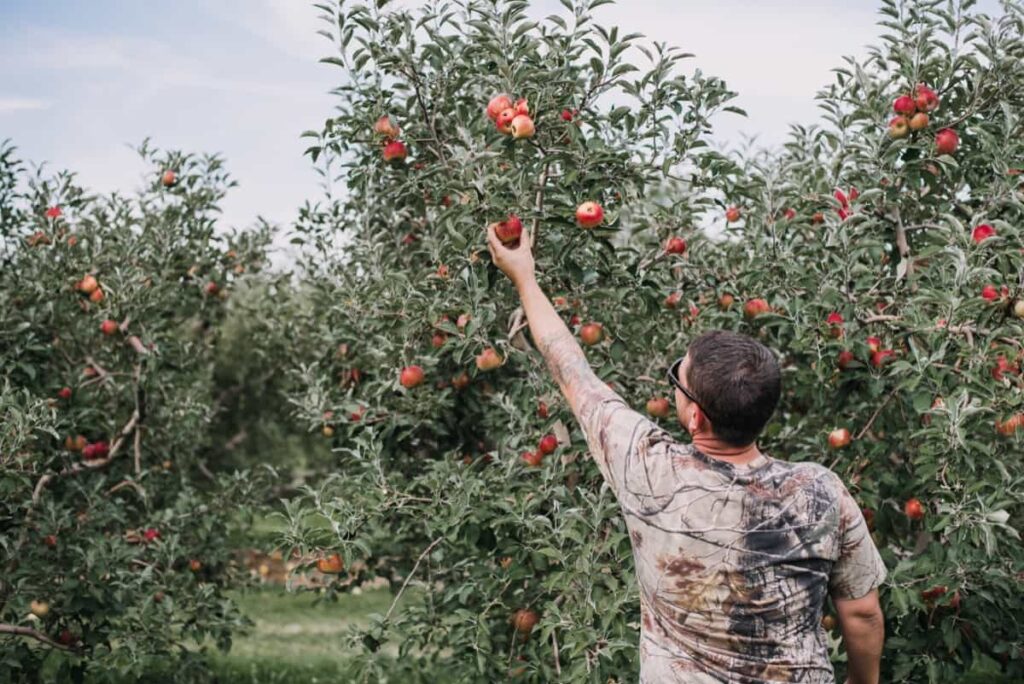
July & August Months Apple Orchard Operations Planning
- Hang sticky ball red traps on branches near the canopy edge, visible from outside the tree, to catch apple maggot flies (AMF). Renew stickiness every three weeks. This will help control the spread of AMF, a common apple pest.
- Apply the first insecticide spray when an average of 1 AMF is caught per trap. Start counting again ten days after application. Respray if/when one more AMF is caught per trap. Traps provide control when used at a rate of 1 trap per bushel, which requires multiple traps per tree.
- AMF should be controlled in mid-to-late July, early August, and mid-August if red sticky traps are not being used.
- Timing should be checked on traps at least twice a week.
- Each insecticide spray prevents AMF egg-laying for approximately ten days or one inch of rain.
- Summer insecticide also reduces the chance of attack by trunk-boring insects.
September & October Month Apple Orchard Operations Planning
Harvesting fruits and cleaning up fallen fruits are essential during this period. Cultivars ripen at different times, so it is necessary to ensure that the harvest is spread over a period to ensure the best quality of fruits. Checking trunks for borer attack sites is necessary, as it can cause structural damage to the tree. Fallen fruit is a food source for voles, and if possible, they should be dug out to prevent any damage. While May and September checks are helpful, conducting a thorough check once a year is crucial to ensure the trees’ health.
November & December Month Apple Orchard Operations Planning
- Rake leaves: Raking fallen leaves helps to prevent the buildup of disease-causing organisms and pests, such as apple scab spores. The leaves can be burned, buried, or mowed to shred and speed decay.
- Trunk guards: Placing trunk guards around the tree trunks can protect them from rodent damage over the winter season.
- Whitewash trunks: Whitewashing the tree trunks helps to protect them from sunscald, which can occur during the winter months. It can also reduce the overwintering apple scab spores and deter insect borers. The coating may also make it easier to find borer attack sites.
- Reflective coating: Applying a reflective coating to the trunk can help to reduce the risk of trunk damage caused by rapid thaw-freeze cycles.
- Rake once: Rake once after all leaves have fallen to ensure the orchard is clear of debris.
- Vole Control: As needed, prevent voles from girdling trunks. Keeping the grass mowed in summer and fall also helps to reduce vole populations.
- Whitewash lasts a year: Whitewashing the trunks should last a year, protecting them until the next winter season.
In case you missed it: Effective Strategies for Managing Insect Pests in Cabbage: A Guide for Farmers and Gardeners
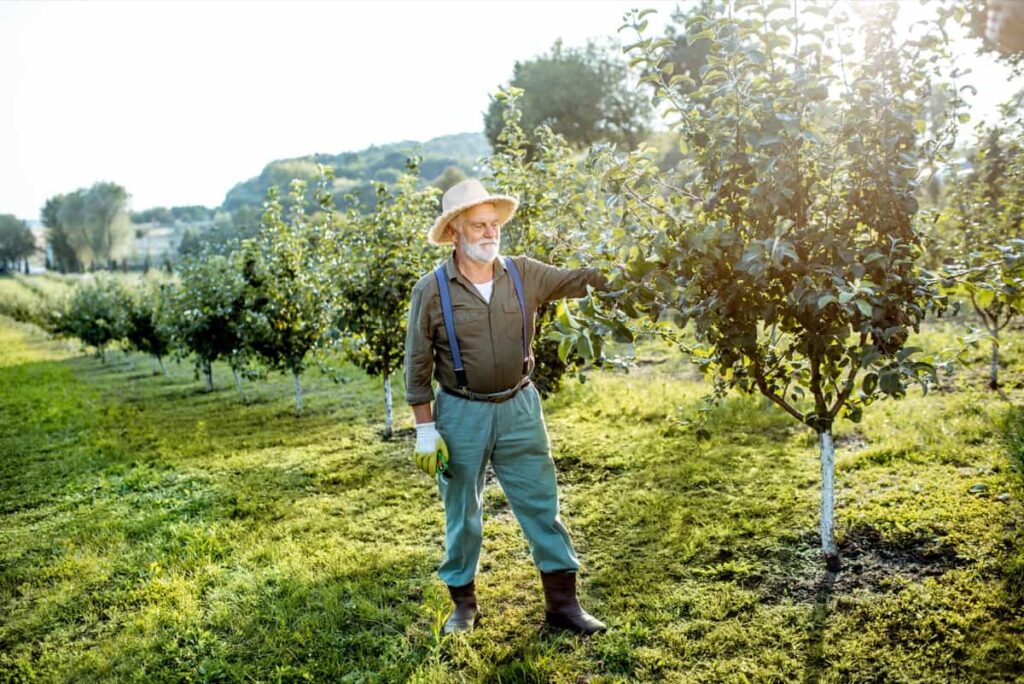
Conclusion
Optimizing apple orchard operations requires careful planning and management throughout the year. Following a month-wise plan, including pruning, fertilizing, pest control, and harvesting activities, orchard managers can maintain healthy trees and maximize fruit production.
- Broccoli Varieties: Choosing the Right Cultivars for Your Farm
- How to Raise Pigs in Your Own Backyard: A Comprehensive Guide
- Budget Friendly Sheep Shed Ideas: Cheap and Low-Cost Tips
- How Much Do Cattle Farmers Make: Revenue Streams in Cattle Farming
- Management Pests and Diseases in Your Cotton Field
- Sheep Farming Business Plan for Beginners
- Aquaponic Farming at Home: A Step-By-Step Guide
- Profitable Village Farming Business Ideas in 2024
- High-Yield Aquaculture: Fast-Growing Fish for Farming
- Effective Fish Pond Construction Techniques for Beginners
- Irrigation and Water Management in Pineapple Farming
- Blossom to Harvest: Mastering Flowering and Pollination in Papaya Farming
- Pig Fattening Essentials: From Selection to Sale for Beginners
- Raising Wagyu Cattle: A Complete Guide for Premium Beef Production
- Soil Types and Their Water Holding Capacity
- Optimizing Irrigation Schedules for Coconut Groves for Enhanced Yield
- Espresso Your Garden: Coffee Grounds for Healthier Acid-Loving Plants
- The Best Soil Mix for Snake Plants: How to Mix Your Own Snake Plant Soil
- Green Thumb Success: Expert Tips for Cultivating Greenhouse Beans All Year Round
- Bloom All Year Round: The Ultimate Guide to Indoor Hyacinth Care
- Eco-Friendly Gardening: How to Make Liquid Fertilizer from Kitchen Waste
- Ultimate Guide to Grow Anise in Pots: Explore Seed Propagation to Harvesting
- Guide to Raising Chester White Pigs: Discover Breed Facts to Growth Management
- Mastering the Elegance: The Ultimate Guide to Weeping Cherry Tree Care, Planting, and Maintenance
- Ultimate Guide to Planting Garlic in Grow Bags: Growing Strategies for Beginners
- How to Fix Spider Plant Leaf-Related Problems: Natural and Organic Remedies
- 10 Reasons Why Your Tulsi Plant is Shedding Leaves: Home Remedies and Solutions
- Optimizing Growth and Yield: The Advantages of Palm Bunch Ash Fertilizer
- Utilizing Neem Oil Extract as a Natural Pesticide for Hydrangea
- From Soil to Harvest: Various Ways in Which Farmers Can Use AI Tools
- Steps to Encourage and Induce Citrus Flowers: A Comprehensive Guide
- How to Fix Snake Plant Leaf-Related Issues: Natural and Organic Remedies
- Transform Your Garden into a Fragrant Oasis with Raat Ki Rani (Night Blooming Jasmine)
- Discover the Ideal Chicken Breeds for Philippine Farms
- How to Create a Poultry Egg Farm Business Plan for Profits
- Grow Lemon Cucumbers Like a Pro: Insider Techniques for Bountiful Yields
